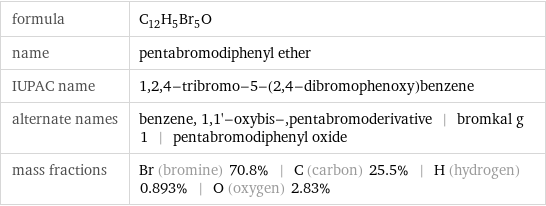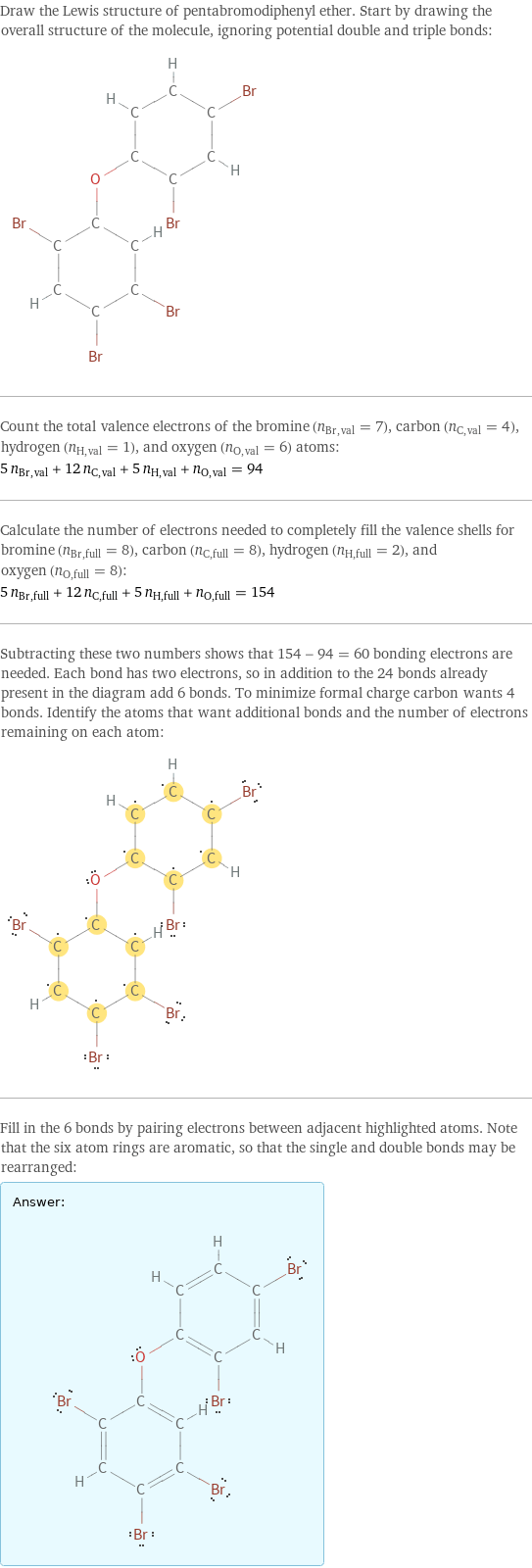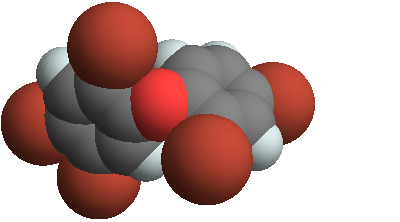Input interpretation

pentabromodiphenyl ether
Chemical names and formulas

formula | C_12H_5Br_5O name | pentabromodiphenyl ether IUPAC name | 1, 2, 4-tribromo-5-(2, 4-dibromophenoxy)benzene alternate names | benzene, 1, 1'-oxybis-, pentabromoderivative | bromkal g 1 | pentabromodiphenyl oxide mass fractions | Br (bromine) 70.8% | C (carbon) 25.5% | H (hydrogen) 0.893% | O (oxygen) 2.83%
Lewis structure

Draw the Lewis structure of pentabromodiphenyl ether. Start by drawing the overall structure of the molecule, ignoring potential double and triple bonds: Count the total valence electrons of the bromine (n_Br, val = 7), carbon (n_C, val = 4), hydrogen (n_H, val = 1), and oxygen (n_O, val = 6) atoms: 5 n_Br, val + 12 n_C, val + 5 n_H, val + n_O, val = 94 Calculate the number of electrons needed to completely fill the valence shells for bromine (n_Br, full = 8), carbon (n_C, full = 8), hydrogen (n_H, full = 2), and oxygen (n_O, full = 8): 5 n_Br, full + 12 n_C, full + 5 n_H, full + n_O, full = 154 Subtracting these two numbers shows that 154 - 94 = 60 bonding electrons are needed. Each bond has two electrons, so in addition to the 24 bonds already present in the diagram add 6 bonds. To minimize formal charge carbon wants 4 bonds. Identify the atoms that want additional bonds and the number of electrons remaining on each atom: Fill in the 6 bonds by pairing electrons between adjacent highlighted atoms. Note that the six atom rings are aromatic, so that the single and double bonds may be rearranged: Answer: | |
3D structure

3D structure
Basic properties

molar mass | 564.69 g/mol phase | solid (at STP) melting point | 388 °C boiling point | 436 °C
Units

Thermodynamic properties

critical temperature | 946 K critical pressure | 4.72 MPa (at STP)
Chemical identifiers

CAS number | 32534-81-9 PubChem CID number | 36159 SMILES identifier | C1=CC(=C(C=C1Br)Br)OC2=CC(=C(C=C2Br)Br)Br InChI identifier | InChI=1/C12H5Br5O/c13-6-1-2-11(9(16)3-6)18-12-5-8(15)7(14)4-10(12)17/h1-5H EU number | 251-084-2 RTECS number | DD6625350
Toxicity properties

RTECS classes | primary irritant